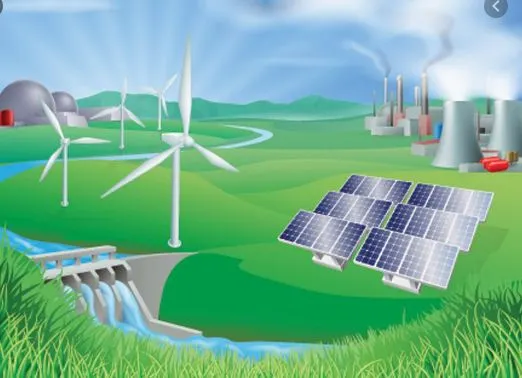
Renewable Energy
Renewable energy, frequently referred to as clean energy, comes from natural sources or processes that are constantly replenished. For example, sunlight and wind keep shining and blowing, even if their availability depends on time and weather. While renewable energy is often thought to be a new technology, connecting nature’s power has long been used for heating, transportation, lighting, and more. The wind has the power to sail a boat in the seas and windmills to grind grain. The sun has provided warmth during the day and helped spark fires to last into the evening. Renewable energy sources have a large potential to displace emissions of greenhouse gases from the combustion of fossil fuels and thereby to mitigate climate change. https://thecliment.com/define-climate-change-adaptation-and-mitigation-top-5-adaptation-and-mitigation-measures/
Renewable Energy Sources and Technologies
Bioenergy
It can be generated from different kinds of raw material, including agricultural, forest, and livestock deposits; short-rotation plants grow in forests, biodegradable municipal solid waste, and other organic waste. By passing through different processes, these kinds of things are directly used to generate electricity and heat. The variety of bioenergy technologies is wide and the technical maturity differs substantially.
Some examples of commonly available technologies include small and large-scale boilers, domestic wood-based heating systems, and ethanol manufactured from sugar and starch. Bioenergy projects usually depend on local and regional fuel supply accessibility, but recent developments show that solid biomass and liquid biofuel trade is increasing internationally.
Solar Energy
Direct solar energy technologies connect the energy of the sun to produce electricity using photovoltaics (PV) and concentrating solar power (CSP), to produce thermal energy, meet direct lighting needs, and theoretically, produce fuels that might be used for transport and other purposes. Many but not all of the technologies are modular, allowing their use in both centralized and decentralized energy systems.
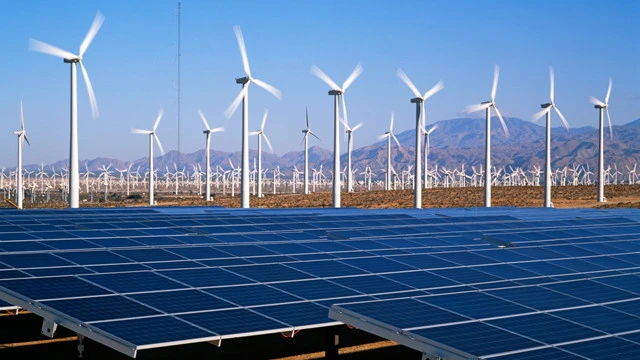
Wind Energy
It harnesses the kinetic energy of moving air. The primary application of significance to climate change mitigation is to produce electricity from large wind turbines located on land, sea, or freshwater. Manufacturing and organization of Onshore (on land) wind energy technologies has done on a large scale. Offshore (freshwater) wind energy technologies have greater potential for continued technical advancement.
Geothermal Energy
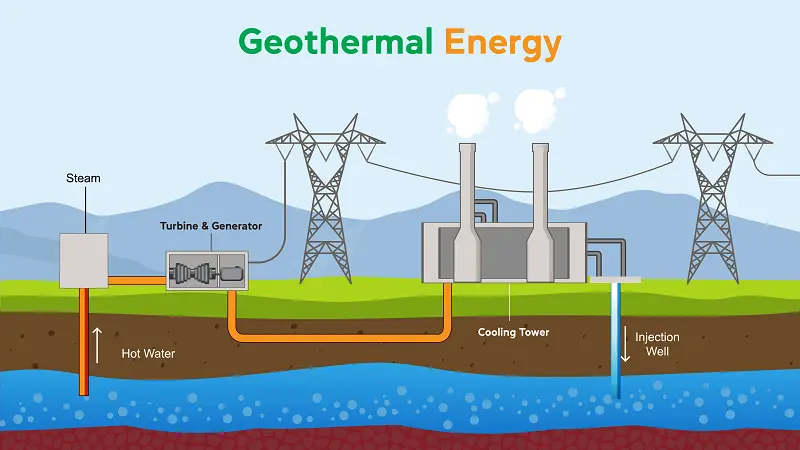
It uses the available thermal energy from the Earth’s center. Heat is extracted from geothermal basins using wells or other means. Reservoirs that are naturally adequately hot and permeable are called hydrothermal reservoirs, whereas reservoirs that are adequately hot but that are improved with hydraulic stimulus are called enhanced geothermal systems (EGS).
Once at the surface, fluids of various temperatures can be used to generate electricity or can be used more directly for activities that require thermal energy, including district heating or the use of lower-temperature heat from narrow wells for geothermal heat pumps used in heating or cooling applications.
Hydropower
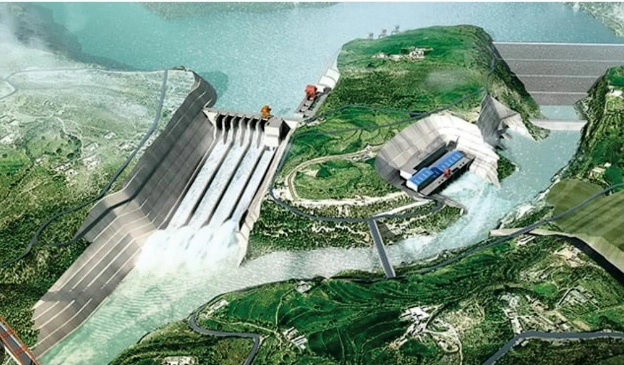
It joins the energy of water moving from higher elevations to lower, primarily to generate electricity. Hydropower projects include dam projects, run-of-river, and in-stream projects and cover a different range of project scales. This diversity gives hydropower the ability to meet large urban needs and rural needs. Hydropower technologies are mature. The process of hydropower reservoirs often imitates their multiple uses, for example, drinking water, irrigation, flood and drought control, and navigation, as well as energy supply.
Ocean Energy
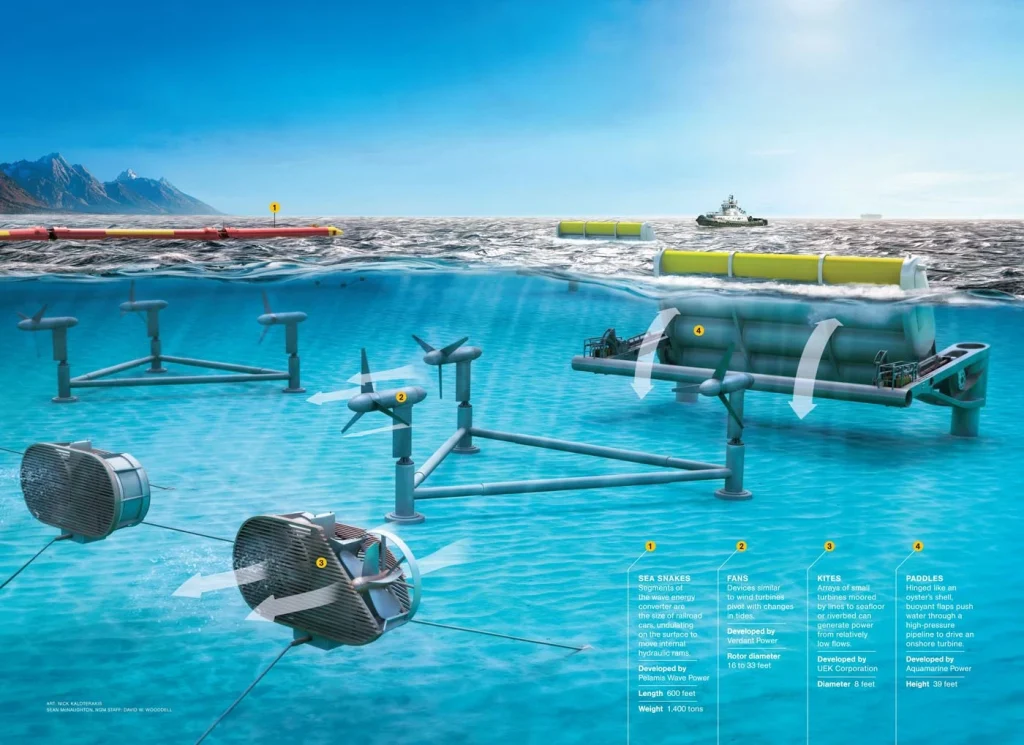
It originates from the potential, kinetic, chemical, and thermal energy of seawater, which converts to provide electricity, thermal energy, or potable water. A wide range of technologies are possible, for tidal range barrages technology, submarine turbines for tidal and ocean currents, heat exchangers for ocean thermal energy conversion, and a variety of devices to harness the energy of waves and salinity gradients. Ocean technologies, except the tidal barrages, are at the demonstration and pilot project phases and require additional Research.
to see more about types of renewable energy: https://education.nationalgeographic.org/resource/renewable-energy-explained/
Renewable Energy is Cheaper
Renewable energy is the cheapest power option in most parts of the world today. Prices for renewable energy technologies are dropping rapidly. Cheap electricity from renewable sources could provide 65 percent of the world’s total electricity supply by 2030.
Renewables are a Global Trend
Decreasing costs have brought corporate sector actors to one platform. Different companies in 75 countries actively sourced 465 terawatt hours of renewable energy in 2017. More than 200 companies reported obtaining at least half of their power needs from renewables.
Instead, they still depend predominately on fossil fuels. Replacing these polluting fuels with renewables is the key to reducing the carbon emissions of these end-use sectors. The transport sector is a good example of such an opportunity.
Major Challenges in Renewable Energy
- Intermittency and Variability: Renewable energy sources are subject to variations due to weather conditions or time of day. This irregularity poses challenges to grid stability and requires effective energy storage solutions to store excess energy during peak production for use during low-generation periods.
- Cost: Renewable energy costs have decreased significantly over the years, and initial capital investments remain high.
- Infrastructure and Grid Integration: The conversion to renewable energy requires wide infrastructure development, including expansion of transmission networks to connect remote renewable resources to population centers.
Technological Development and Potential Solutions
- Advancements in energy storage: Energy storage technologies play a crucial role in addressing irregular renewable energy generation. Batteries and grid-scale storage systems allow the efficient utilization of excess energy during high-generation periods. Additionally, the use of hydrogen as an energy transporter shows promise for long-duration storage and various energy applications.
- Smart grids and digitalization: Implementing smart grids supports efficient demand-side management, facilitating load balancing and reducing energy waste. Digitalization increases grid optimization, real-time monitoring, and control, enhancing the integration of renewable energy sources and maximizing their utilization.
- Research and development: Continued investment in research and development is important for overcoming renewable energy challenges.
- Advanced monitoring and predictive analytics: Establishing advanced monitoring systems and predictive analytics in renewable energy installations can enhance performance, detect faults, and facilitate predictive maintenance. Real-time monitoring of renewable energy assets permits for early detection of issues, enabling quick actions to prevent system failures and increase energy generation.
Renewable Energy Sector in Pakistan
Pakistan’s energy sector remains one of the main obstacles to economic growth. Although Pakistan has managed to increase power generation since 2013 and mitigate power blackouts that plagued the country over the past decade, expensive fuel sources, reliance on imported energy products, chronic natural gas shortages, major debt in the power sector, and aging and insufficient transmission and distribution systems have prevented the sector from growing and modernizing.
Weak governance, uncoordinated energy policymaking, and a lack of long-term energy planning only add to Pakistan’s current energy woes. U.S. and international assistance have helped Pakistan make some major strides in addressing these problems but without major reforms, Pakistan’s energy future remains challenging. With the current government’s tilt towards renewable energy, the Ministry of Energy revised the current Renewable Energy (RE) Policy 2019.
According to the revised RE policy, the Government of Pakistan aims to derive 60 percent of energy from renewable sources including hydro by 2030 which would wean Pakistan’s dependence on imported fuel products.
Key Challenges of Development of Renewables in Pakistan
There are several challenges for developing nations like Pakistan for massive development of their renewable energy sources. List is as follows;
- Lack of investment
- Balance of Payment Issue
- High cost needed
- Lack of infrastructure
- Political instability
- Limited awareness and education
- Security concerns
Conclusion
Advocating for renewables, or using them in your home, can hasten the transition toward a clean energy future. Even if you’re not yet able to install solar panels, you may be able to choose electricity from a clean energy source.
 The Climent Respect your roots, Protect your planet
The Climent Respect your roots, Protect your planet

3 comments
Pingback: The Environmental Benefits of Wind Energy: A Sustainable Solutions - The Climent
Pingback: What is Solar Energy? 12 Surprising Benefits of Solar Energy - The Climent
Pingback: Energy and Mineral Resources Types and Negative Impacts - The Climent